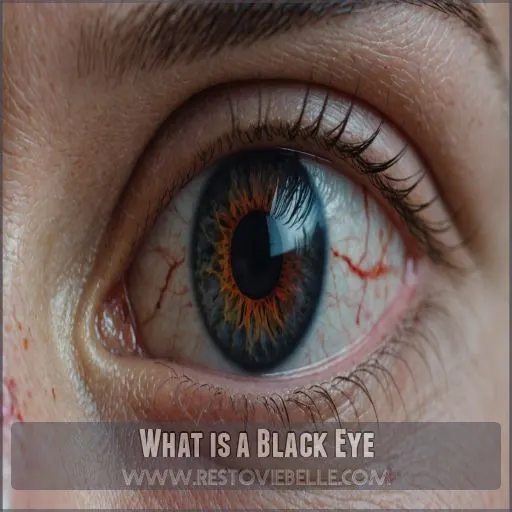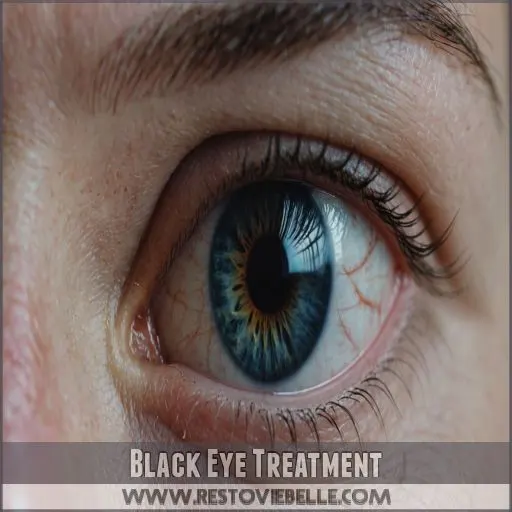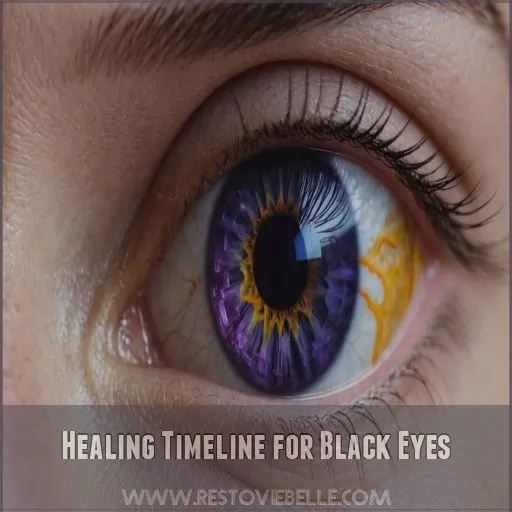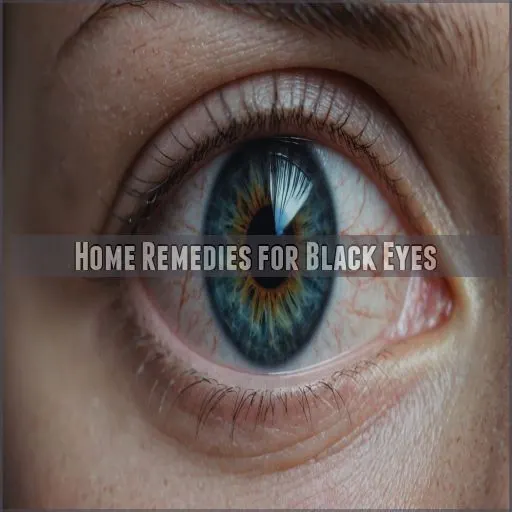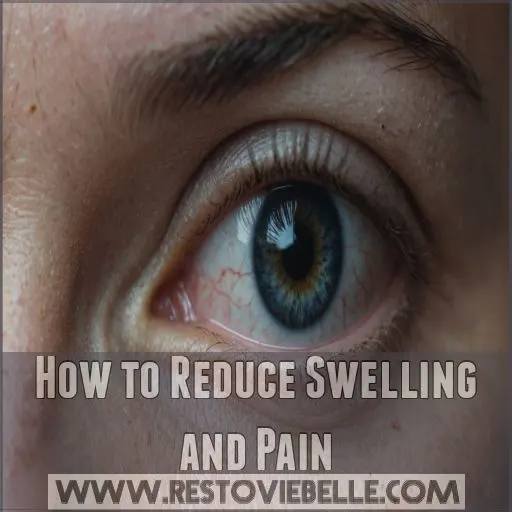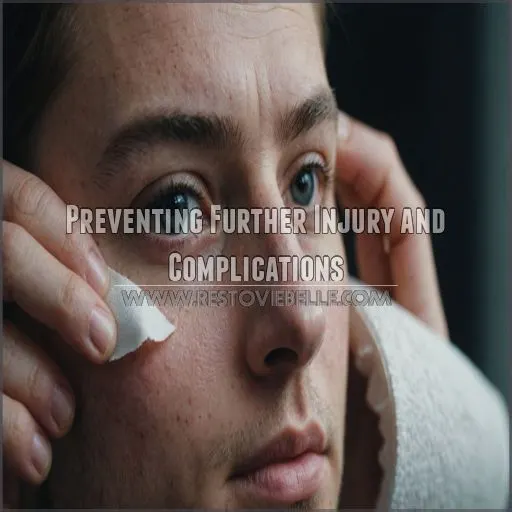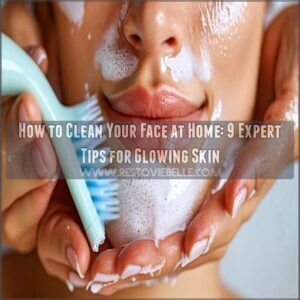This site is supported by our readers. We may earn a commission, at no cost to you, if you purchase through links.
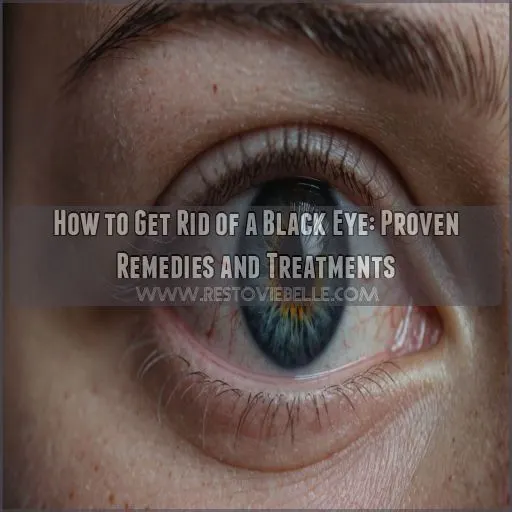 Got yourself a shiner and need to know how to get rid of a black eye? Start by applying a cold pack or a bag of frozen peas to the area right after the incident—it’s like giving your eye a mini-vacation.
Got yourself a shiner and need to know how to get rid of a black eye? Start by applying a cold pack or a bag of frozen peas to the area right after the incident—it’s like giving your eye a mini-vacation.
This reduces swelling. After a couple of days, switch to a warm compress to boost blood flow and healing.
Over-the-counter pain relievers can take the edge off, but be gentle with any massages; you want a soothing spa, not a deep tissue workout!
Keep reading for tips on arnica and other home remedies that could speed up your healing journey.
Table Of Contents
- Key Takeaways
- What is a Black Eye
- Black Eye Treatment
- Healing Timeline for Black Eyes
- Home Remedies for Black Eyes
- How to Reduce Swelling and Pain
- When to Seek Medical Attention
- Preventing Further Injury and Complications
- Frequently Asked Questions (FAQs)
- How can I make my black eye go away faster?
- How long does a black eye last?
- How do you get rid of a bruise in 24 hours?
- Does rubbing a black eye help?
- Can makeup hide a black eye effectively?
- What foods promote faster bruise healing?
- Are children more susceptible to black eyes?
- Can stress affect black eye recovery?
- How can a doctor diagnose complications from a black eye?
- Conclusion
Key Takeaways
- Got a shiner? Quick tip: start with a cold pack right after the incident to reduce swelling, and switch to a warm compress after a couple of days to boost healing. It’s like giving your eye a cool and then a cozy vacation.
- Remember the RICE method: rest, ice, compression, and elevation. It’s your knight in shining armor when dealing with a black eye, speeding up recovery more effectively than a magic spell (which, sadly, we’re fresh out of).
- Stock up on home remedies like arnica cream and vitamin c for that extra healing push. They’re like your bruise-busting sidekicks, swooping in to save the day.
- If your eye’s colorful journey seems stuck in the sequel to ‘abstract art,’ or you’re seeing double, it’s time to see a doctor for a closer look – think of it as calling in the reinforcements.
What is a Black Eye
You know that mysterious, dramatic shiner that can make you look like you’ve been in a brawl?
That’s a black eye, caused by trauma to the face resulting in broken blood vessels under the skin, often leaving a colorful surprise around your peeper.
Causes of a Black Eye
A black eye, or periorbital hematoma, can come from a sports injury, a fall, or even a bump during a workplace accident.
Sometimes, life’s curveballs like car accidents or domestic violence might unfortunately lead to one.
It’s like your face had a little boxing match without your permission!
Good news is, with a cold compress and gentle massage, healing’s around the corner.
Symptoms of a Black Eye
You’ve taken a blow, and suddenly, your eye’s sporting colors worthy of an abstract painting. You’re seeing swelling, pain, and that classic bruising—blue turning to purple, eventually morphing into green and yellow.
Sometimes, a distant relative, "raccoon eyes", may stop by, but don’t panic if only one eye’s invited to the party.
If vision changes or persistent pain crash the festivities, consult a doctor.
Black Eye Vs Raccoon Eyes
While a black eye is typically caused by a single blow, raccoon eyes indicate a more serious injury.
These occur when blood pools around both eyes, often signaling a skull fracture or brain trauma.
If you experience raccoon eyes, seek immediate medical attention, as they may indicate a life-threatening condition.
Black Eye Treatment
Got a shiner and feeling like a raccoon?
Don’t worry, with simple remedies like ice packs and gentle massages, you’ll be on your way to looking less like a prizefighter and more like yourself in no time!
RICE Method for Black Eyes
A black eye’s no picnic, but the RICE method—Rest, Ice, Compression, and Elevation—can be quite the knight in shining armor, speeding healing and reducing swelling.
It’s simple yet effective.
Cold Compress for Black Eyes
To start healing, apply ice packs soon after the injury.
Cold compress for black eyes reduces swelling and pain.
Wrap ice in a cloth, apply gently—timing’s key for the best results!
Warm Compress for Black Eyes
Once the cold compress has done its magic, switch to a warm compress.
Follow these tips for success:
- Use soft cloth materials.
- Apply gentle heat.
- Relieve lingering tenderness or excessive swelling.
Chilled Cucumber Therapy
After enjoying warm compresses, consider chilled cucumber therapy‘s soothing properties for skin hydration and anti-inflammatory effects.
Just place cool slices on your black eye, relaxing while cucumbers work magic.
Avoid using if infections persist, as it may not be suitable for anti-inflammatory effects in such cases.
Gentle Massage for Black Eyes
For those black eyes, a gentle massage—like coaxing a cat to purr—can boost circulation and quicken healing.
Mind pressure sensitivity, please.
Explore bilberry extract or symphytum officinale, but avoid severe pain.
Over-the-Counter Pain Medication
Over-the-counter meds like acetaminophen or ibuprofen can ease black eye pain.
Just be mindful of dosages and avoid anything that could interact with your meds or health conditions.
Your comfort is key.
Healing Timeline for Black Eyes
Healing a black eye can take you on a rollercoaster ride of colors as bruising fades from purple to yellow over a couple of weeks.
From bananas to rainbows, you’ll know when you’ve fully recovered when your face no longer resembles modern art!
Swelling and Bruising Stages
When you have a black eye, swelling typically peaks after two days, making you feel like a prizefighter in a losing round.
This swelling timeline varies, though, especially after facial surgery or due to behavioral changes.
Stages include initial swelling, tender bruising progression, and eventual, slow healing phases.
Color Changes During Healing
As you journey through the swelling and bruising stages, you’ll notice a "kaleidoscope" of colors.
Initially, the bruise color stages resemble a deep purple, then shift to bluish hues.
In the healing color spectrum, these vibrant shades gradually fade into greens and yellows, like nature’s palette.
When to Expect Full Recovery
As your black eye’s color transforms, gauging the recovery timeline becomes key.
Full healing usually takes about two weeks, akin to watching paint dry.
During these stages, watch for signs like fading bruises.
However, if you notice bleeding from the ears or nose, see a doctor. A visit to the doctor can also provide reassurance if the bruise doesn’t change for the worse in about 14 days after it formed – around two weeks – similar to watching paint dry in which one could look forward to a change – akin to 14 days which one waits – that of full healing usually.
Factors Affecting Healing Time
The healing time for a black eye can feel like waiting for paint to dry.
Factors that speed up or slow down recovery include:
- Injury severity
- Age and health
- Quality of treatment
- Lifestyle choices
Home Remedies for Black Eyes
Banishing a black eye might feel like waiting for ketchup to pour out of a glass bottle—slow but inevitable.
Don’t worry, you can speed things up with easy home remedies like arnica, vitamin C, and comfrey cream for a smoother healing journey.
Arnica for Black Eyes
Healing a black eye isn’t just about waiting it out—embrace topical arnica.
This herb, touted for its bruise-busting skills, can be a game-changer.
For arnica application tips, apply formulations precisely, avoiding sensitive areas.
While beneficial, check for arnica side effects and follow arnica dosing guidelines.
Vitamin C for Black Eyes
Let’s give Vitamin C its time in the spotlight!
When you’re grappling with a black eye, consider these benefits:
- Topical Vitamin C: Enhance healing with creams.
- Vitamin C Dosage: Boost absorption with supplements.
- Benefits: Say goodbye to bruising faster!
Comfrey Cream for Black Eyes
Got your eye on natural remedies? Comfrey cream could be your new ally.
Known for its herbal properties, comfrey has been traditionally used for healing.
While efficacy studies are limited, applying it gently might help. Just keep an eye out for any safety concerns.
Other Natural Remedies
As the eye quietly heals, you might consider turmeric or ginger, both known for their anti-inflammatory properties.
Witch hazel offers a soothing touch. A sprinkle of bromelain found in pineapple could help too.
For a relaxing twist, soak in an Epsom salt bath and unwind, incorporating anti-inflammatory properties to aid in the healing process.
How to Reduce Swelling and Pain
If you’ve ever looked in the mirror and thought you’ve morphed into a panda with a black eye, don’t fret—there’s hope.
Reducing swelling and pain can be as simple as ice packs and elevation, helping you look more like yourself in no time.
Elevation and Rest
Relaxing with your feet up isn’t just for luxury—it’s for recovery!
Elevation benefits swelling reduction.
Choose pillow heights wisely; think comfy cloud, not pancake.
Rest positions should resemble napping star-fish, ensuring quicker recovery time.
Sleep tips? Dream of fluffy sheep and wake up healing!
Ice Packs for Black Eyes
Reach for an ice pack to soothe that painful black eye. Apply it for 15-20 minutes, a few times a day. The cold helps reduce swelling and ease discomfort. Wrap the pack in a thin towel to avoid direct skin contact. Icing is a simple yet effective way to kickstart the healing process.
- Apply ice pack for 15-20 minutes
- Repeat application 2-3 times per day
- Wrap ice pack in a thin towel
- Icing helps reduce swelling and pain
Warm Compresses for Black Eyes
You’ve been chilling with ice packs, but it’s time to crank up the heat a little!
Warm compress benefits include increased blood flow and healing.
Use a clean cloth, soaked in warm water, on your eye for 15-20 minutes, three times daily—you’ve got this!
Gentle Massage for Pain Relief
After applying a warm compress, gentle massage can work wonders for pain relief.
Use your fingertips with light pressure—like you’re calming a skittish kitten.
Aim for short sessions of a few minutes.
Massage techniques to improve blood flow help boost blood flow to the scalp.
Consider using comforting massage tools for added ease.
When to Seek Medical Attention
While a black eye usually fades away on its own, sometimes it can be a little too persistent or start showing worrying signs, like trying to steal the spotlight in a boxing match.
Severe symptoms or vision changes are a cause for concern.
If you notice these, it’s time to call in the pros and seek medical attention.
Severe Symptoms Requiring Medical Help
If you experience blurry vision, double vision, or blood in your eye, don’t wait – see a doctor right away. These severe symptoms could signal a more serious injury and require prompt medical attention to prevent further complications.
- Blurry or double vision
- Blood inside the eye (hyphema)
- Persistent, severe headache
Signs of Infection or Complications
Watch for infection signs like fever, increased redness, or discharge.
It’s better to be safe than sorry before things get out of hand and your black eye becomes more than a colorful memory!
If you notice any of these, it’s time to see a doctor.
Persistent Black Eye Symptoms
When your black eye seems to have moved in permanently, it’s time to think about calling in reinforcements.
Keep an eye out for:
- Persistent pain that just won’t quit
- Skin discoloration or bruising increase
- Headache concern that’s got you reaching for the aspirin each morning.
Vision Changes or Double Vision
Even superheroes can’t blink away vision changes or double vision! When your peepers go wonky, it’s a red flag.
Keep an eye on things like eye strain, strabismus, and sudden blurriness.
Prioritize eye health by consulting a doctor, ensuring you’ve dotted all the "i"s and crossed the "t"s.
Preventing Further Injury and Complications
Protecting your eyes is important after a black eye. Take steps to avoid contact sports and wear protective eyewear to prevent further injury and speed up your recovery.
Avoiding Contact Sports
Avoiding contact sports while nursing a black eye is like dodging a storm to stay dry.
Consider alternative physical activities to keep the momentum without risk.
Impact on healing can steal the show if ignored, so lean into gym safety tips and reduce those sports injury risks.
Wearing Protective Eyewear
Sure, the best contact sport strategy also involves safety goggles or stylish fashion eyewear—looking sharp while staying safe is totally a thing.
For sporty types, sports helmets offer key protection.
Prescription lenses with UV protection add an extra layer of defense, letting you see clearly and feel secure.
Preventing Future Trauma to the Face
Well, nobody likes sporting a shiner!
Future-proof your face with these safety tips:
- Protective Headgear: Stay ahead of bumps with proper gear.
- Mouthguards for Sports: They save your smile.
- Helmet Safety Tips: Helmets aren’t just for bad hair days.
- Eyewear Precautions: Safeguard those peepers!
Additional Treatments for Black Eyes
Sticking your nose in a book might be safer than contact sports.
For extra healing, try arnica cream, vitamin C supplements, or comfrey cream.
Need fast results? Laser treatment can help speed things up.
Concealer application might save face, literally, until you heal.
Frequently Asked Questions (FAQs)
How can I make my black eye go away faster?
Don’t worry, you can get that black eye looking better in no time!
Start by applying ice, keeping your head elevated, and taking over-the-counter pain meds.
With a little TLC, you’ll be back to your bright-eyed self in no time.
How long does a black eye last?
A black eye usually sticks around for about two weeks.
Think of it as your face’s way of showing off those colorful souvenirs from life’s little adventures.
Thankfully, it gradually fades, shifting from purple to green and yellow.
How do you get rid of a bruise in 24 hours?
Kiss that bruise goodbye!
Although magic wands are in low supply, start with ice packs to reduce swelling.
After 48 hours, switch to warm compresses.
It speeds circulation and healing, but patience is your best ally!
Does rubbing a black eye help?
Rubbing a black eye is like trying to iron out the wrinkles in a marshmallow—futile and messy.
Instead, let gentle care, ice, and time work their magic for proper healing and comfort.
Can makeup hide a black eye effectively?
Covering a black eye with makeup is as easy as pie!
Use a color-correcting concealer—yellow or peach for blue tones—and finish with foundation.
Blend like a pro; you’ll be ready for your close-up in no time!
What foods promote faster bruise healing?
Eat the rainbow to speed up bruise healing.
Leafy greens, citrus fruits, and bell peppers pack a vitamin C punch, while eggs and meat boost iron.
Antioxidant-rich berries are your secret weapon to vanish those blues.
Are children more susceptible to black eyes?
Kids are like little whirlwind adventurers, often getting bumps and bruises.
With thinner skin and more delicate tissues, they’re slightly more prone to black eyes.
Encourage safe play and watch for signs needing a doctor’s attention.
Can stress affect black eye recovery?
Can stress affect black eye recovery? You bet it can!
Stress slows healing, so try to relax.
Sip some chamomile tea, take deep breaths, and let your body do its thing – those black and blue shades will fade in no time.
How can a doctor diagnose complications from a black eye?
Doctors diagnose black eye complications through physical exams, checking your vision and eye movements, and sometimes using CT scans or X-rays to see hidden issues.
It’s like detective work to make sure nothing’s lurking beneath the surface (Source).
Conclusion
Got a colorfully artistic eye? Don’t worry, with patience and the right care, you’ll soon learn how to get rid of a black eye.
Start by treating it gently using cold and warm compresses and trying out home remedies like arnica and Vitamin C for that extra push.
Keep an eye on any lingering symptoms and seek medical help if needed.

